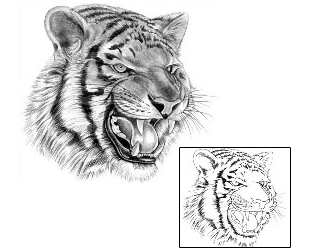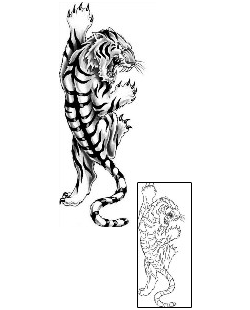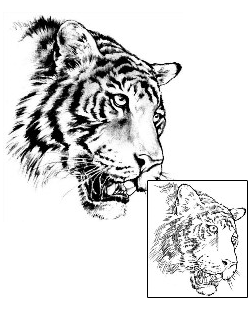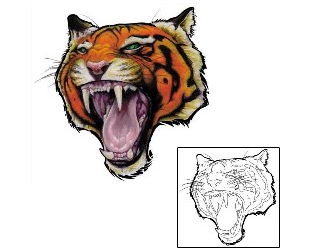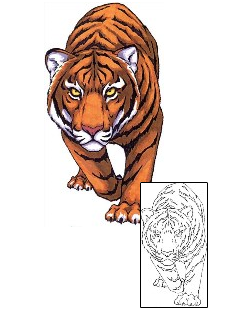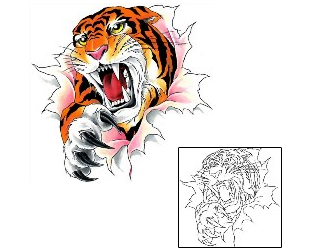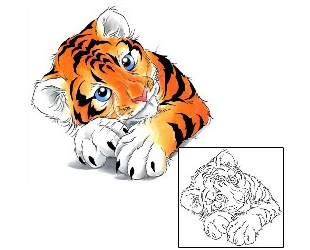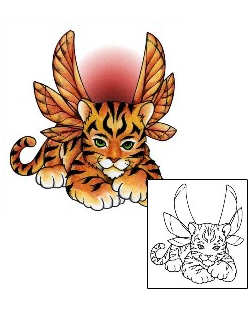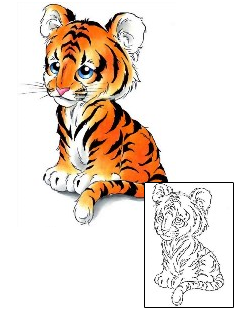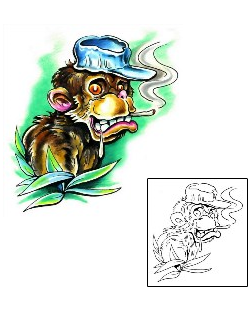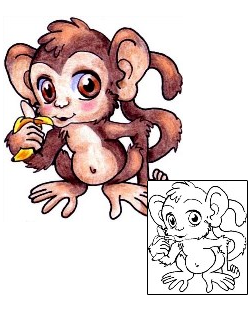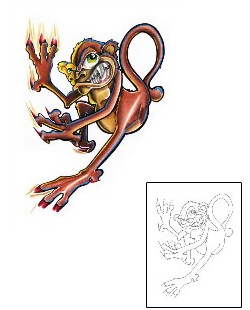Thanks to their astounding beauty and endangered status, tigers (panthera tigris) have invaded the hearts and minds of people across the globe. The tiger has also managed to get "under the skin" of many men and women and the traditional body art of tattoo. Clawing forth out of their human hosts or stalking across arms, backs or thighs, the tiger has become a coveted image to bear. White tigers, tiger cubs and saber-toothed tigers all stare out at us from human flesh, testifying to their eternal qualities of strength, courage, and at times- ferocity.
Tigers Today
It's sad to note that then population of tiger tattoos more than likely far outweighs the actual number of tigers surviving today on our planet. It is estimated that there are only an estimated 5000-7500 tigers of all varieties alive in the wild. In the last 70 years alone, three subspecies of tigers have become extinct: the Bali, Javan and Caspian tigers. Once a coveted "treasure", the skins, bones and lives of tigers are now all currently protected by national laws and penalties. Tigers can still be found in their natural habitats in India, Nepal, Bhutan, Bangladesh, Vietnam and possibly even China.
Tigers are by far the largest of all big cats, with the largest subspecies, the Siberian tiger, weighing in at 500 pounds or more. The smallest of the breed is the Sumatran tiger, with the males weighing in at only about 250 pounds. In the tiger world, the males of the species nearly always outweigh their female counterparts.
Solitary and primarily nocturnal creatures, only mothers and cubs (whose family unit is known as a streak) live together for any amount of time. To avoid any potential disputes, tigers will mark their territory in the jungles and forest by using acts like scratching on tree trunks, and the standard feline practice of "spraying". And when it comes time to for their night-time stalking and hunting, the tiger is well equipped. Their night vision surpasses human ability by 600%!
It has been these natural abilities and strengths that have inspired the world around them with tiger related myths, legends, rituals and homage.
The Mind Behind the Design: Tigers in Myth, Legend and Dreams
The tiger has inspired man for as long as the two have shared the earth. The fear has been one that has morphed itself from terror, aggression, admiration, emulation and protection. And the most popular and magical of all of these myths come from the very land of the tigers themselves: Asia.
China and the 5 Mystic Tigers:
In the lore and legend of the Chinese, the world is ruled over by five unique tigers. The first is the red tiger, who ruled the South, Summer and Fire. The second is the black tiger, ruling the North, Winter and Water. Third comes the blue tiger, in charge of the East, Spring and Vegetation. Fourth is the white tiger, reigning over the West, Autumn and all Metals. Above them all, sits the Yellow Tiger, who is the ruler of the Earth and all of its different energies.
The Tiger in Chinese Astrology:
Recent and future Years of the Tiger include: 1914, 1926, 1938, 1950, 1962, 1974, 1986, 1998, and 2010.
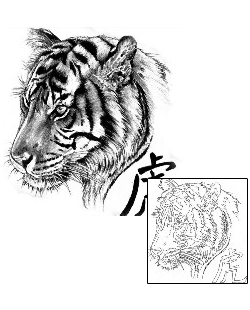
Individuals who are born in the Year of the Tiger are often born leaders with a slight tendency to be loners or who enjoy frequent "time to themselves". Their primary focus in life is to follow their ambitions and to always maintain control.
Full of courage and born masters of seduction, these lovers also have the ability (and desire) to fight the good fight unto even the most bitter of ends. Moody or sensitive, Tigers need to learn to apply the Greek principle of "The Middle Way", and lean towards practicing moderation in all things.
As an Asian symbol, the meaning of the tiger is quite diverse. In Asia in general, tigers are associated with the power and might of Kings. In Korea, the tiger is referred to as the "King of the Animals". In India where Hinduism prevails, Shiva in the form of the destroyer wears the skin of a tiger while riding atop a tiger's back. The Chinese use images of tigers on charms in an effort to ward off evil, and during the Chou dynasty, pictures of tigers hung in rooms of pregnant women to protect their unborn children. The power of the image of the tiger has made it an ideal choice in the world of tattoo design.
Tibetans and the Na-his (of the Yannan province) people of China believed that they were descendants of tigers. And to the people of Asia at large, tiger attacks were often viewed as a person receiving a divine punishment for their sins. It was also popular to hear legends of were-tigers, the tiger's equivalent of the werewolf.
Tigers: A Western Perspective
In the Native American culture, the tiger is regarded as a very powerful totem spirit. This spirit is most renowned for its passion, power and devotion. It is also the symbol of darkness and the New Moon. If you were to suddenly find yourself befriended by this lonesome totem, you should be on the lookout for new adventures and a new awakening of passion and power. As such, the totem's power lends to us a strong sexual energy and eroticism.
However, it is also associated with the water, and because of this shares all of the element's properties including:
Healing
Power through Gentle Flow (going with the flow)
Feminine Energies
The tiger is also plays its part in the world of dream interpretation and symbolism. Tigers in our sleeping dreams represent our driving force in life, or to be more primal, our basic urges. To dream of a caged tiger indicated that we have these urges and forces under control. Dreaming of tigers can also be a way for your subconscious mind to give form to its feminine qualities, vengeance or cunning.
Choosing Your Tiger Tattoo Design
You'll find the tiger a very versatile figure in nearly any kind of tattoo. There are tiger tattoo designs where the tiger is clawing its way outside of your skin. You can choose a more simplified, tribal style design for your tiger, and position it across your back and shoulders. Tigers pair well with dragons, snakes and other big cats like panthers and lions.
To pay tribute to children, you could choose a tiger cub design.
Or design your own tiger streak, with the addition of siblings and (unorthodox) the father. You can choose from Chinese tiger designs, or the ancient saber-tooth tiger. Or, you can simply choose a tattoo design that is inspired by the tiger. Such designs include images such as:
Tiger's eye (gemstone)
A tiger lily
Tiger sharks
Or simply give yourself stripes, with a tiger skin tattoo.
Whatever shape or form the tiger within you takes, it is just waiting for you to let it emerge.


